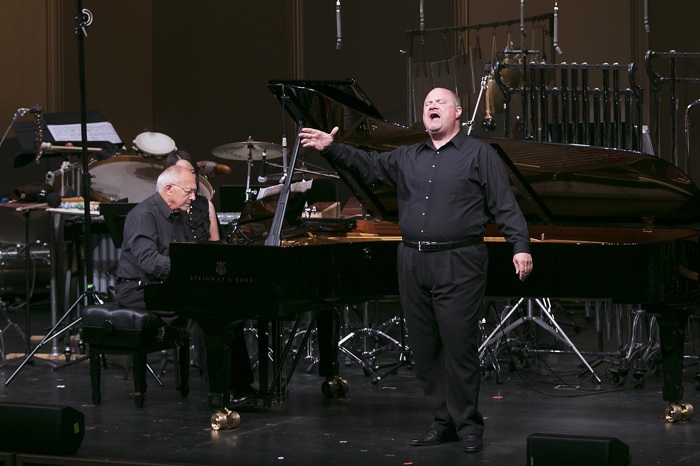Dvořák’s America
On Thursday, June 31, Music@Menlo had its fifth concert program, “American Visions,” at the Menlo-Atherton Center for the Performing Arts. Held in several Peninsula halls, this summer chamber music festival is now midstream in its 12th season, and deservedly achieving fame.
As part of a festival dedicated to Dvořák, this concert followed his early twentieth century travels to America, where he used our domestic folk material in his own Bohemian composing, just as he had earlier mined rich Czech folk idioms.
The stage was stuffed with exotic percussion instruments, but we didn’t get to hear them until the second half, when four percussionists, pianist Gilbert Kalish, and baritone Randall Scarlata performed George Crumb’s American Songbook II, written in 2002. These nine difficult songs were technical miracles, full of polyrhythms and sliding tonalities. Scarlata sang soulful renditions of Gospel standards as the percussionists marched off in diverse directions.
As for Kalish’s piano, it made an excellent percussion instrument, and was more often plucked than pounded! This was a present-day moment of an arc of intention that began with Dvořák’s experimental combinations of folk and classical.
But first we were treated to works of early and mid-Americana. Louis Moreau Gottschalk was touring the world at the beginning of the Civil War, and rushed back to concertize and fundraise for the North. His “The Union” was an immensely popular mash-up of the Star Spangled Banner and Yankee Doodle, and he even performed it for Lincoln. Pianist Gilles Vonsattel executed this with over-the-top salvos of pianistic artillery, from huge reverberant bass chords to passages appropriate for villains and “damsels-on-the-tracks.” But it moved beyond special effects with a grim ending that evoked drum rolls and the heavy treads of war.
Pianist and M@M Festival founder Wu Han next appeared with violinist Arnaud Sussmann for Dvořák’s Sonatina in G-Major, Op. 100, which he wrote in 1893 while in the States. Native American melodies were reworked with Viennese lilt for a creation that stewed native corn in a European goulash, engaging but a little jarring.
Shortly after this period, Charles Ives was also experimenting on combining classical with folk. Scarlata took the stage with Kalish for Ives’ Selected Songs for Baritone and Piano, six songs that spanned from 1890 to 1920. At times amusing and at times deeply pungent, these were bravely done, with Scarlata often wandering without a reference key as Kalish wrung huge chords from the piano.
Crumb’s work, inspired by Ives’ experiment, was originally notated for amplified voice as it was based on traditional Appalachian material, with crooned consonants and de-emphasized vowels (think “non-operatic”). “Swing low, sweet chariot” opened with an aura of soft pentatonic sounds in the tuned percussion. Scarlata sang sweetly with perfect placement, rounded and peachy. Hammered tubular bells invoked Charles Ives (a hero of Crumb) and village churches, as the four percussionists joined together in exquisite workmanship.
In “Joshua fit the battle of Jericho,” Kalish crouched over the piano to pound out traditional chords while plucking the insides, and then picked up a shofar and blew a long blast. This was music of vitality, with shouts and driving rhythms and even a hammered thunder sheet.
These nine songs each had their own character, but shared a very painterly kind of instrumental color. One hissed with a slither of brushes while another thundered, and a last one felt like water drops, rounded dollops of sound with perfect ripples.
Once described as “a shaman of sound,” Crumb defines a private language, symbolist and at times reverent, through trilled square waves and drifting keys. Silvering the air with bright attacks and long decays, this semi-tonal language is very much at odds with the baritone, but echoes and supports it nonetheless.
This concert’s thoughtful programming illustrated two worthy and chancy causes: the combining of popular and classical, and the mixing of different musical cultures. Dvorak’s ethnomusicology, Crumb’s moving Appalachia, and Ives small-town America succeeded at both for a rare treat.
—Adam Broner
Photo, below, of Pianist Gilbert Kalish and baritone Randall Scarlata; photo by Tristan Cook. Not pictured: percussionists Florian Conzetti, Christopher Froh, Ayano Kataoka and Ian Rosenbaum.

